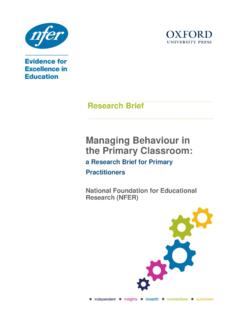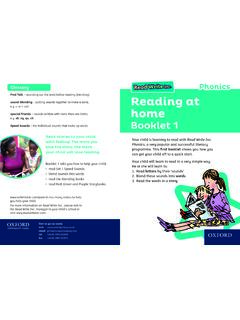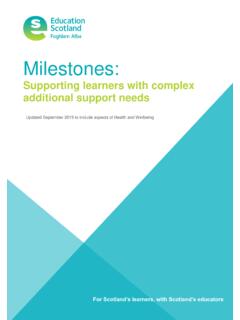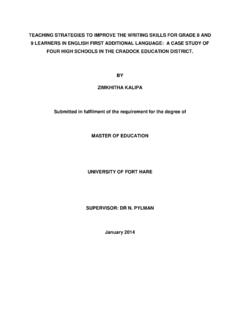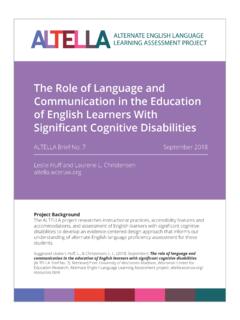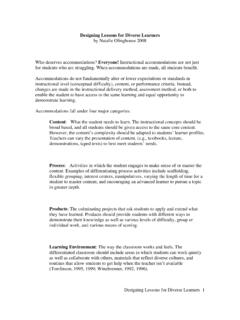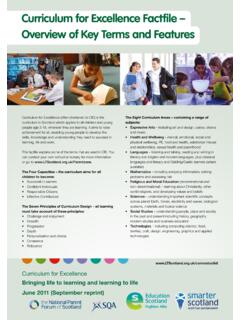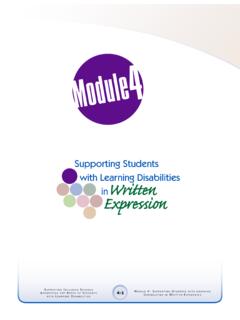Transcription of Revised A Guide to Supporting EAL Learners
1 A Guide to Supporting EAL LearnersWritten by Caroline Crolla and Jeanine Treffers-DallerRevised and updated 2 0171 Oxford University Press 2017 No sharing, copying or adaptation of materials permitted except by subscribers to Oxford Owl. Artwork: David Semple; P1 and P12 Oxford University Press; P2 Corbis; P4 Paula Solloway/Alamy; P6 The Photo Library Wales /Alamy; P7 Andrew Fox/Alamy; P8 Paula Solloway/AlamyExtracts from DfSE materials are reproduced under the terms of the Open Government is this Guide for?Teachers, headteachers, and all those working specifically with children learning EAL, and local education authority support services in primary Learners and mainstream education ..2 Background researchCognitive benefits ..3 Vocabulary ..3 Learner-to-learner communication ..3 Code switching ..3 support in the classroomAssessing a new pupil ..4 Planning lessons ..5 Tips for putting it into practice ..6 Challenges in language learningRecognising the challenges.
2 7 Parents and community: Supporting pupils learning ..8 Funding ..8 Pupil portraits Anna ..9 Amal ..10 Further support Oxford University Press resources ..11 Useful resources ..11 Further reading ..11 Endnotes ..12 About the authorsCaroline Crolla has had a career in teaching English, drama and media studies in several schools in both Kenya and the UK. She has been Head of English, Senior Teacher and Deputy Headteacher in secondary schools before moving into teacher education. She is particularly interested in English as an additional language (EAL); grammar and knowledge about language; assessment for learning; and leadership in schools. She currently is Head of Initial Teacher Treffers-Daller is Professor of Second Language Education and Director of the Centre for Literacy and Multilingualism. She is particularly interested in how depth and breadth of vocabulary knowledge affect academic achievement and in how monolinguals and multilinguals differ from each other in the range of words they use orally or in writing.
3 2 Oxford University Press 2017 No sharing, copying or adaptation of materials permitted except by subscribers to Oxford Owl. Learners and mainstream educationThe term English as an additional language (EAL) is commonly used in mainstream UK education to describe children who speak one or more languages in the home and who are learning much of their English in an educational setting. The term English as a second language (ESL) is used widely internationally, however, there has been criticism of the term for the implication that English is the second language when, for many children, it is actually their third or fourth language. Children learning EAL/ESL are often also known as bilingual . In this Guide , the term bilingual learner has been adopted to mean children who have at least two languages in their repertoire, but who may not have equal competence in each language. The percentage of children in our primary schools who speak English as an additional language has risen from in 2013 to in Most of these children belong to well-established ethnic minority communities, and have been born and educated in the UK.
4 EAL support is typically concentrated at key stages 1 and 2, those in the early stages of learning English (current funding is for the first three years of learning English), under the assumption that bilingual Learners will catch up with their monolingual peers and will then require similar teaching and learning experiences. However, the features of academic language need to be taught explicitly if EAL pupils are to achieve as well as their monolingual peers as their language develops. One in five pupils in primary schools in England is learning EAL. 1 Key messages Established good practice for pupils learning EAL is largely good practice for all pupils. Teachers should explicitly model language structures and patterns. Initial whole-school processes for assessment of language, learning and pastoral needs on entry is crucial as is developing a welcoming ethos that reflects diversity and culture. Children who are learning EAL will learn more quickly alongside fluent users of English who can provide good language and learning role models.
5 Research shows that it can be important to encourage new arrivals to write both in English and their first language, where appropriate, and to have access to bilingual resources and first language texts; this will increase the speed of their English proficiency. Learning EAL should not be considered to be a Special Educational Need (SEN). Test scores will not accurately reflect the potential of a pupil who is in the early stages of learning EAL and should not therefore be used as the main criterion for placing the pupil in a teaching group. Learn about their previous education and ability in their first Oxford University Press 2017 No sharing, copying or adaptation of materials permitted except by subscribers to Oxford Owl. researchFigures from the Department for Education show that pupils whose first language was English outperformed those whose first language was not English in all four elements of key stage 1,3 although there are important differences between children from different backgrounds and some are very successful.
6 (See Further reading for more information). All schools, but in particular those with large numbers of children learning EAL, face the challenge of finding effective ways to raise the levels of achievement in language-related subjects, as well as in other subjects for those Learners . For teachers, it is essential not to conflate the surface social playground conversational English, Basic Interpersonal Communicative Skills (BICS) with the secured English language ability necessary for academic progress, Cognitive Academic Language Proficiency (CALP). The distinction between BICS and CALP, first proposed by Cummins (1979)4 was later elaborated into a new model of communicative proficiency, which analyses communication along two dimensions: the first one refers to the amount of contextual support that is available; and the other one refers to the range of cognitive demands that are involved in communicative tasks (see Figure 1). Activities which take place in the classroom are often cognitively demanding as well as context-reduced (top right quadrant), which makes these particularly challenging, by comparison with language used in the playground (bottom left quadrant) (see also Gibbons (1991),5 for the distinction between playground language and classroom language).
7 Hal et elaborates on this model demonstrating that EAL pupils need to be supported with work concentrated in the top left quadrant as their language develops, so that they can eventually operate successfully in the top right quadrant where academic literacy undemandingcommunication (BICS)Cognitively demandingcommunication (CALP)Context-reducedlanguage (CALP)Context-embeddedlanguage (BICS)Example: comparing and contrasting Example: arguing a case Example: saying helloExample: listening to a story Figure 1 The Cummins frameworkCognitive benefitsWhile a considerable amount of research has been carried out into the challenges faced by children learning EAL, it is less well known that there are also important cognitive benefits of being brought up bilingual. Bilingual Learners demonstrate an advantage over monolingual Learners in non-verbal tasks requiring attentional control, such as card sorting tasks where children need to select figures on cards according to shape and then Bilingual Learners are better at switching from one instruction to the next, possibly because they are used to juggling two languages and suppressing one language whilst using the Learners often have a smaller vocabulary in each language than monolinguals do,8 and do not always have a translation equivalent for each English word in their other language, although the total vocabulary will be comparable.
8 So, teachers will need to be aware of the fact that subtle conceptual distinctions, such as the difference between a cup and a mug, may need to be taught as they may not exist in the child s first language(s). Teachers should also be mindful that some words in English have more than one meaning in different contexts, such as table. Learner-to-learner communicationTeachers are often fearful about allowing children to communicate in a language they themselves do not However, studies have highlighted the increase in motivation that young bilingual Learners demonstrate when encouraged to speak with each other, for example, in Bengali, as in Kenner s (2010) research in southern switchingBaker (2006)11 suggests that code switching (the use of two or more languages in one conversation or even one sentence) may be the most personally efficient manner of communicating for bilingual Learners , but despite recent research demonstrating how useful it can be, it is often not accepted by teachers in the classroom and Oxford University Press 2017 No sharing, copying or adaptation of materials permitted except by subscribers to Oxford Owl.
9 In the classroom Assessing a new pupilEstablished good practice for pupils learning EAL is largely good practice for all pupils. Schools which are serious about knowing their pupils well will know the value of initial whole-school processes for assessment on entry. This includes an initial family interview, buddying with an able English speaker (or a bilingual learner with the same first language) and introduction to the school. The basic entry questions about how long/if the pupil has been educated, ability in their home language, cultural norms and expectations regarding education, personal interests and beliefs, are all essential knowledge to know how and what to plan in the English FOCUS Placing a new arrival in an appropriate class or group:Children who are learning EAL will learn more quickly alongside fluent users of English who can provide good language and learning role models. If possible, place the pupil in a class or group that includes a pupil who speaks the same language.
10 A child with little or no previous experience of schooling needs careful consideration. It may seem appropriate initially to place them in the year below their chronological age or in a lower group. However, there can be disadvantages to such a strategy. Research shows that maintaining an age-appropriate curriculum and securing high cognitive challenge are critical to progress for children learning EAL. Therefore, it is important to differentiate lessons to enable access according to pupils needs. Use visuals, graphic organisers and practical activities alongside clear language patterns for pupils to express understanding. See EAL should not be considered to be a Special Educational Need (SEN) and bilingual Learners should not be automatically identified for SEN support , as this is likely to be inappropriate to their needs. Avoid placing children learning EAL in groups with low-achieving children or with children with SEN. Assessment of SEN is complex and should not be undertaken too soon after the child arrives in school.


